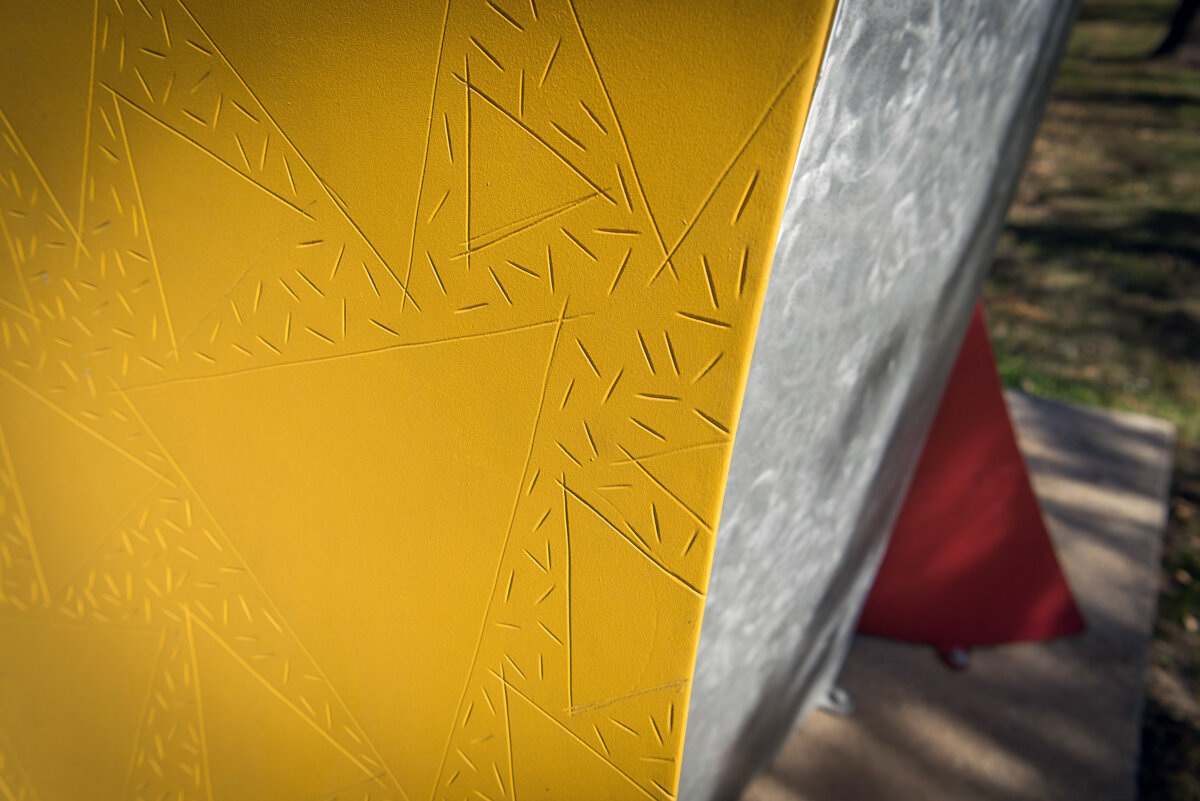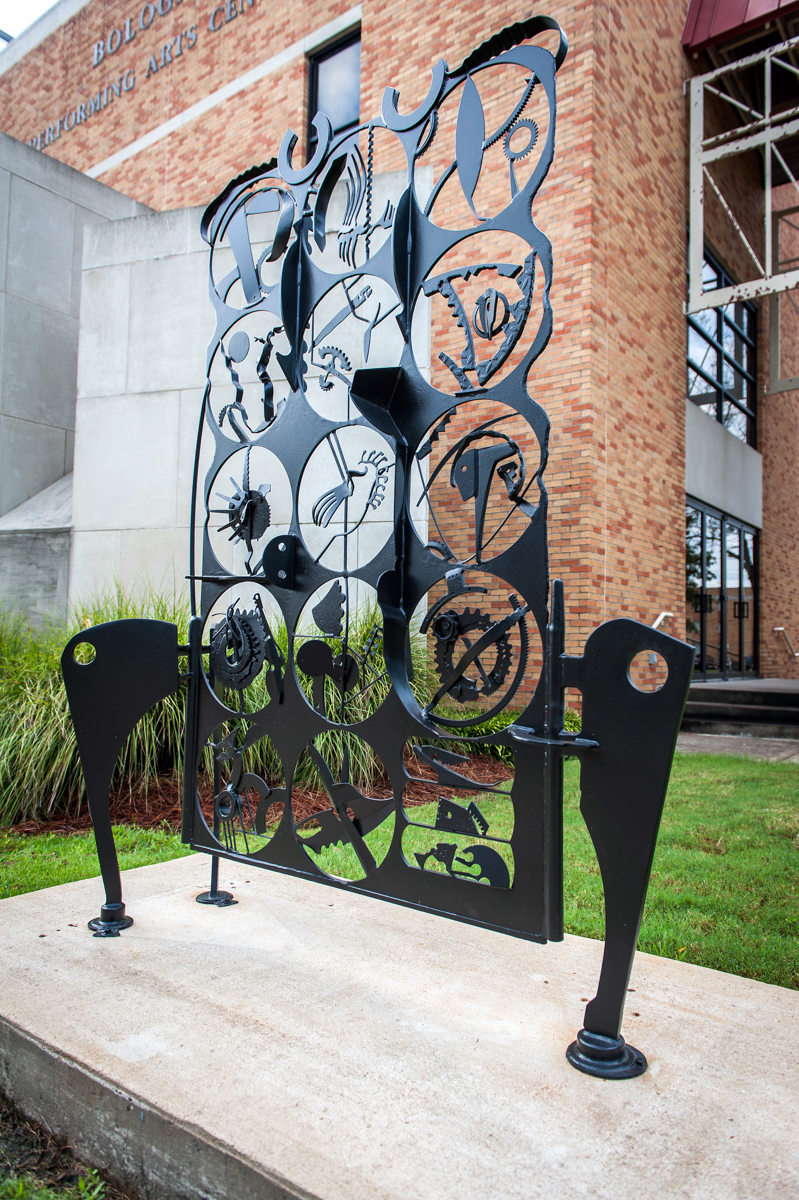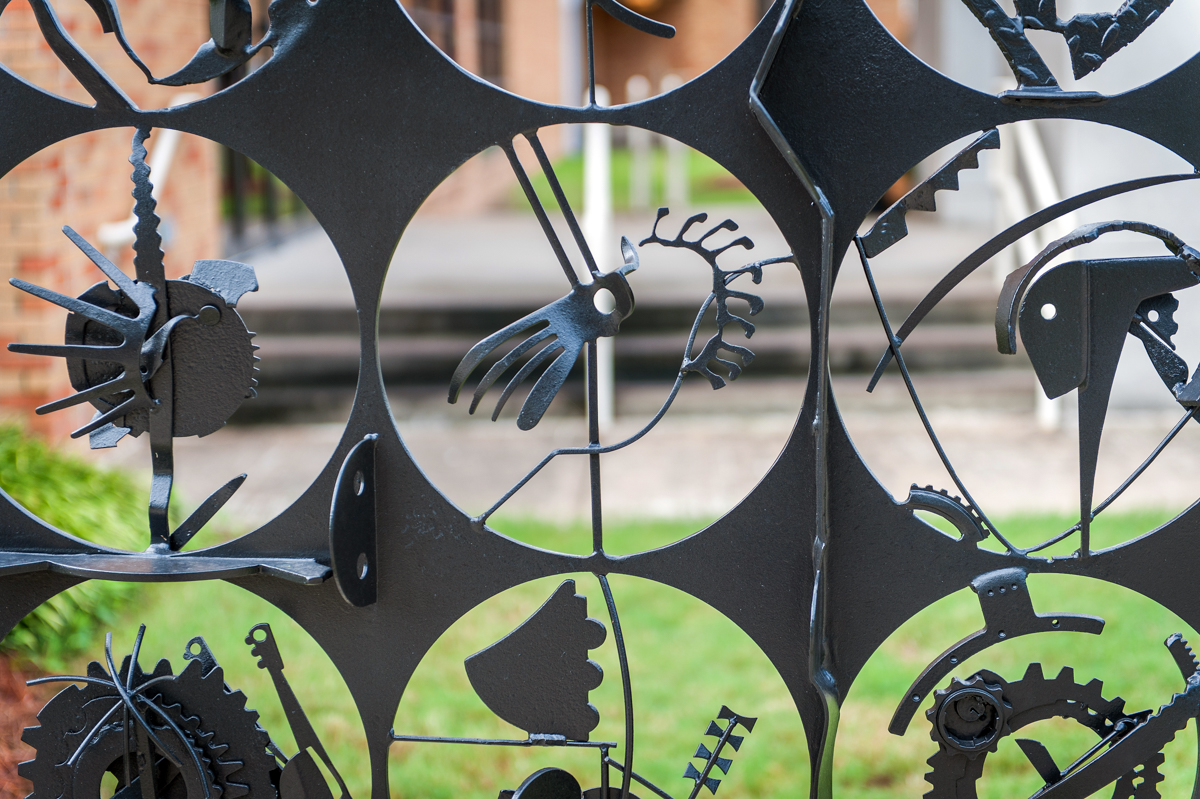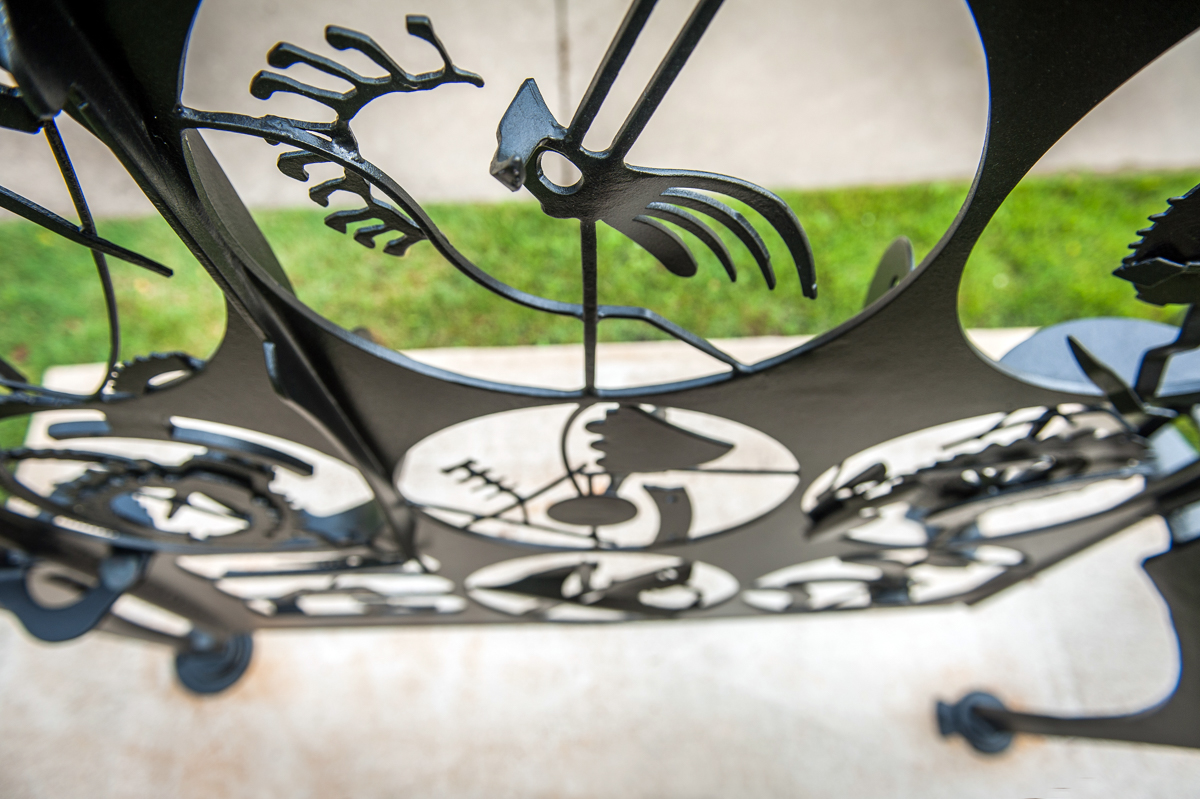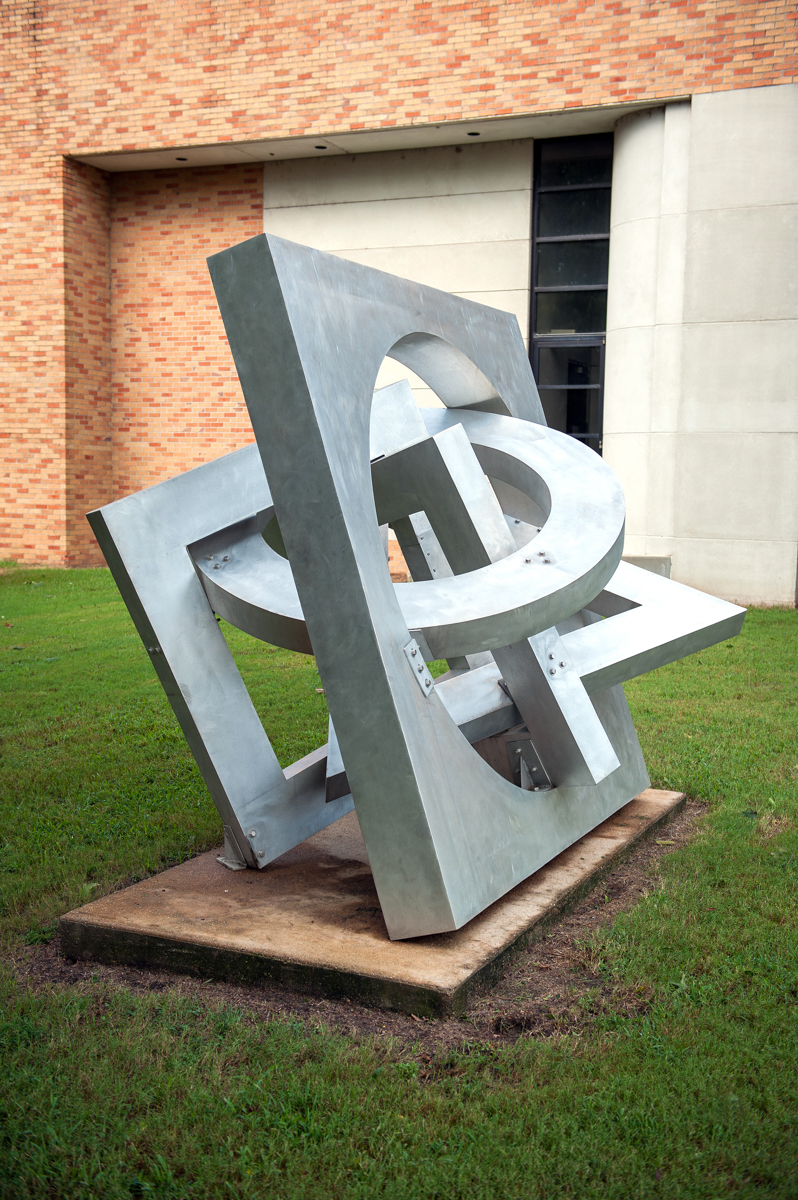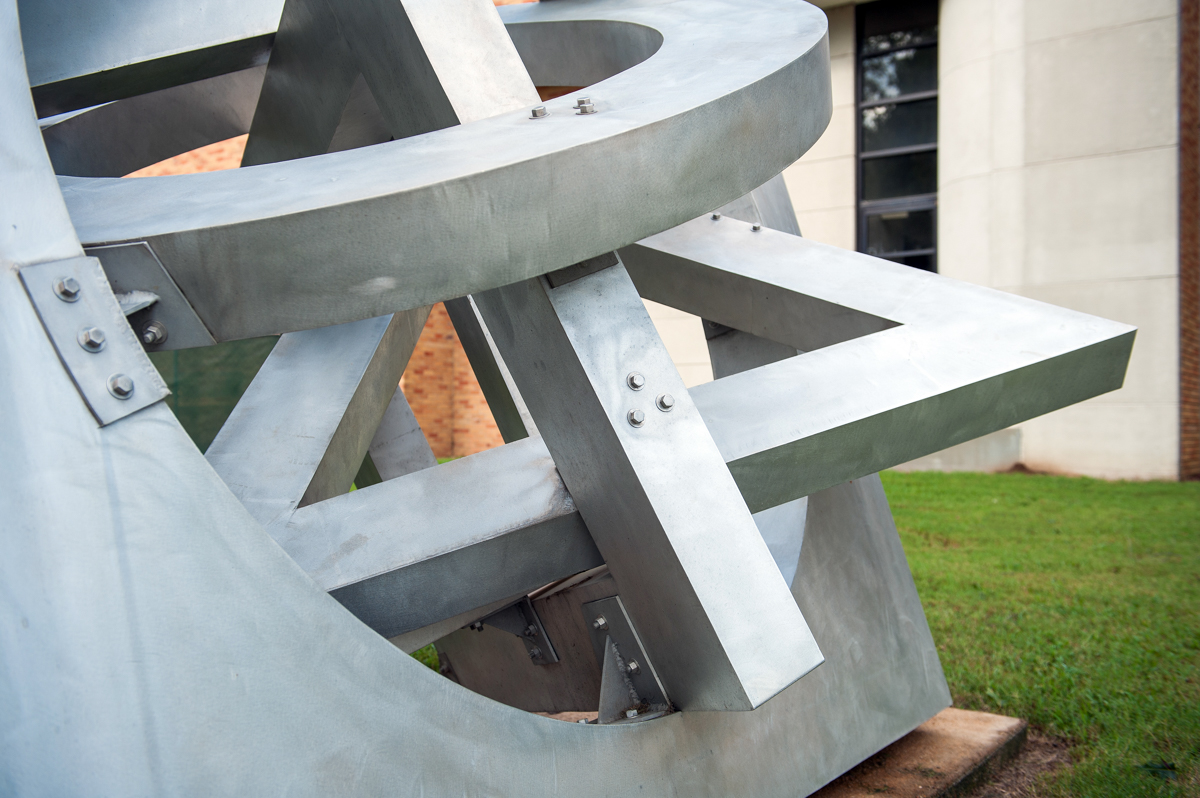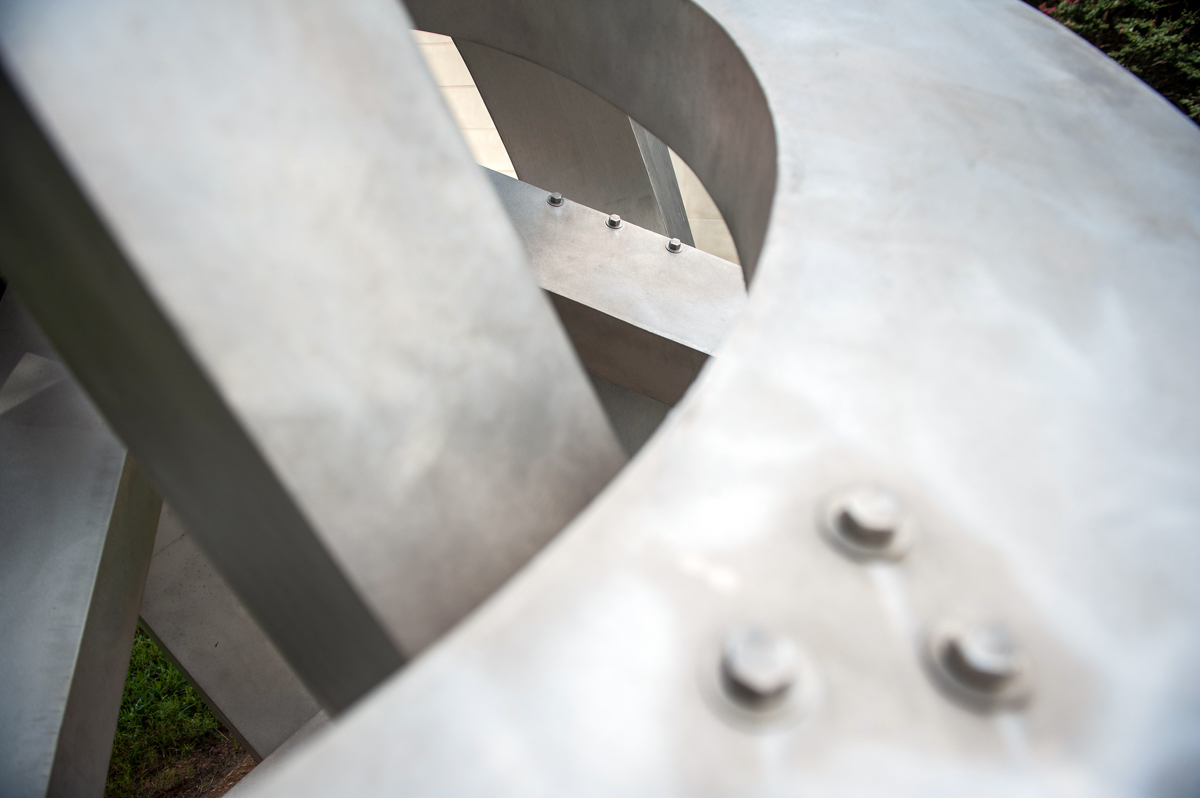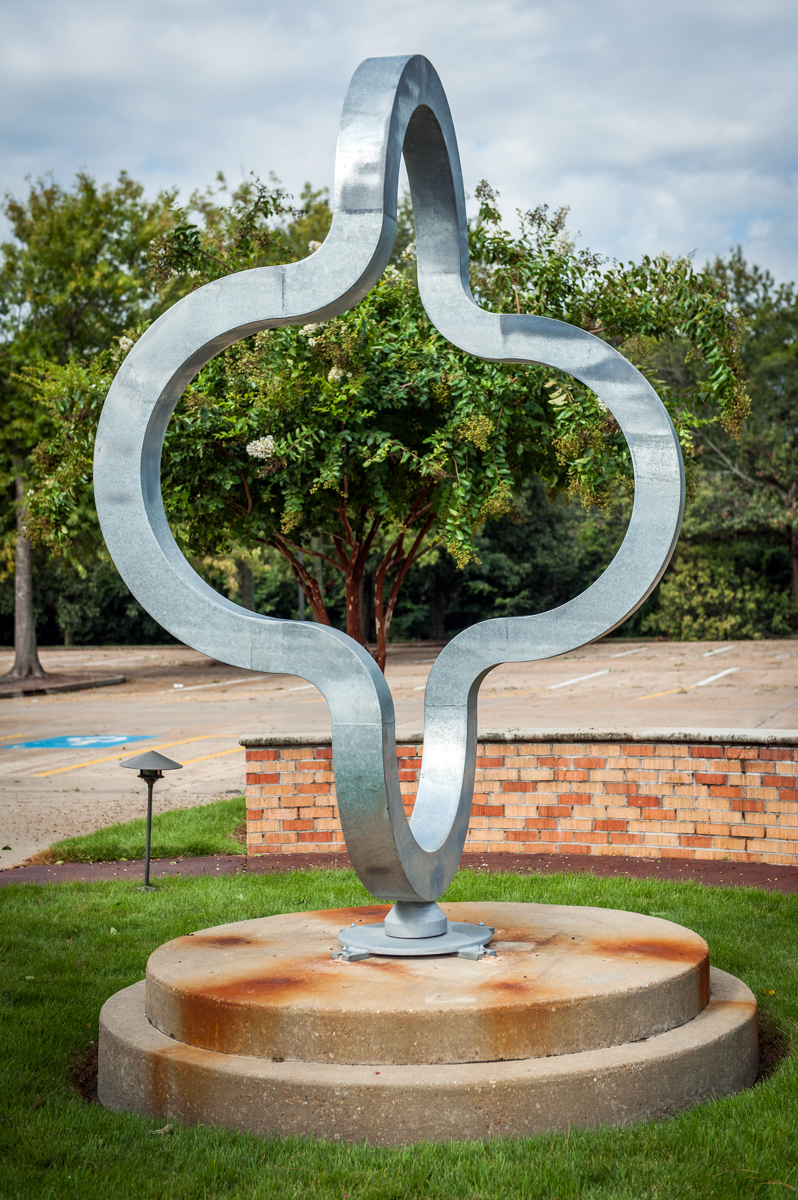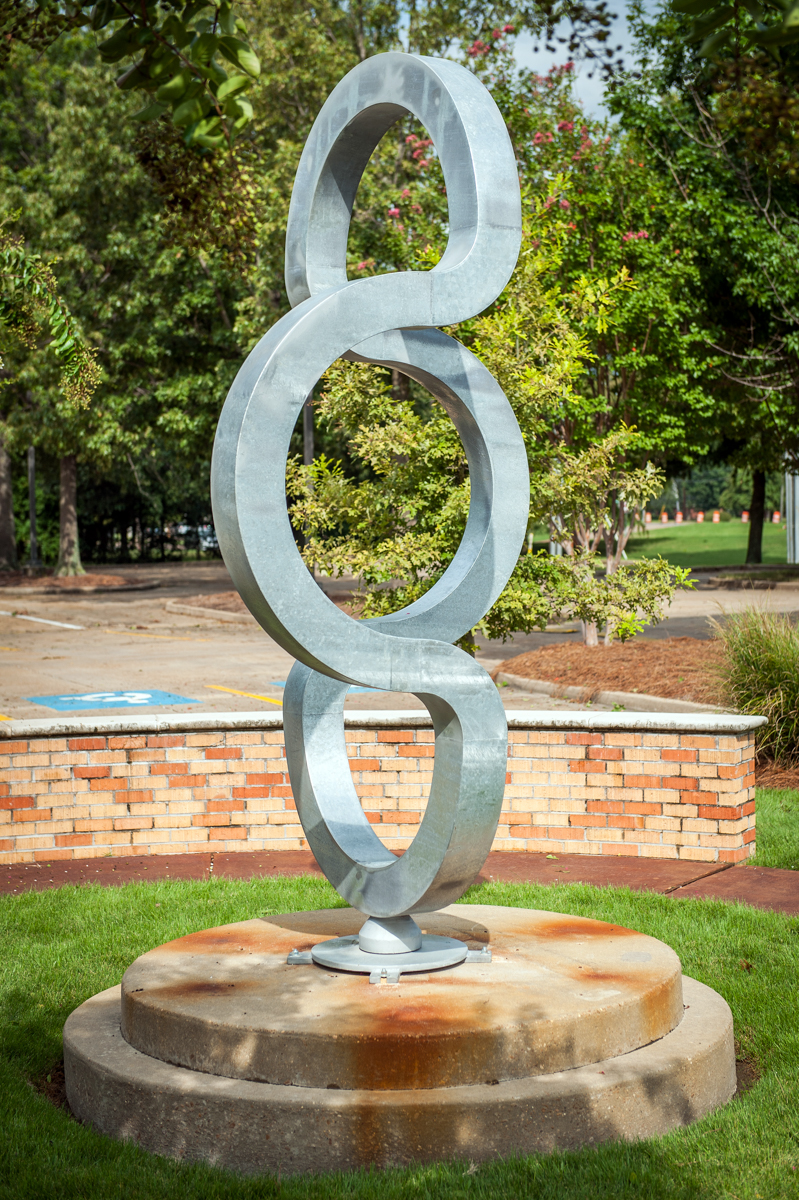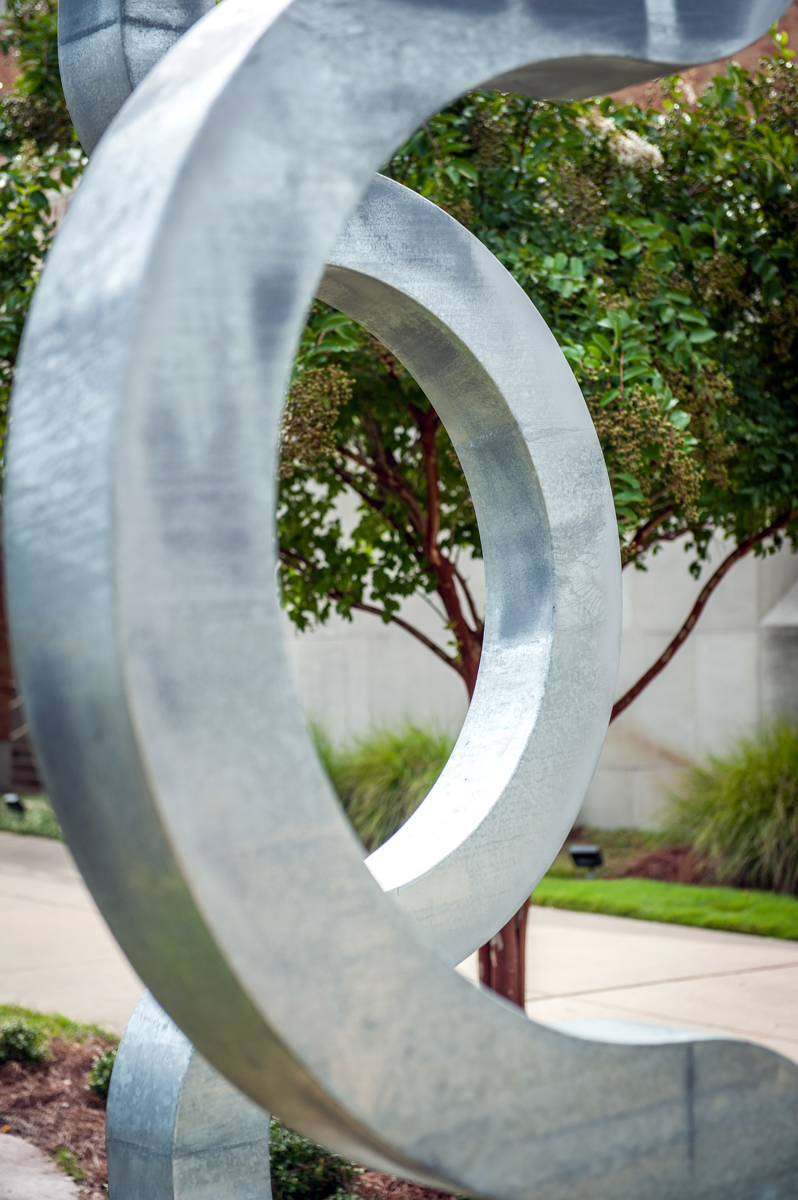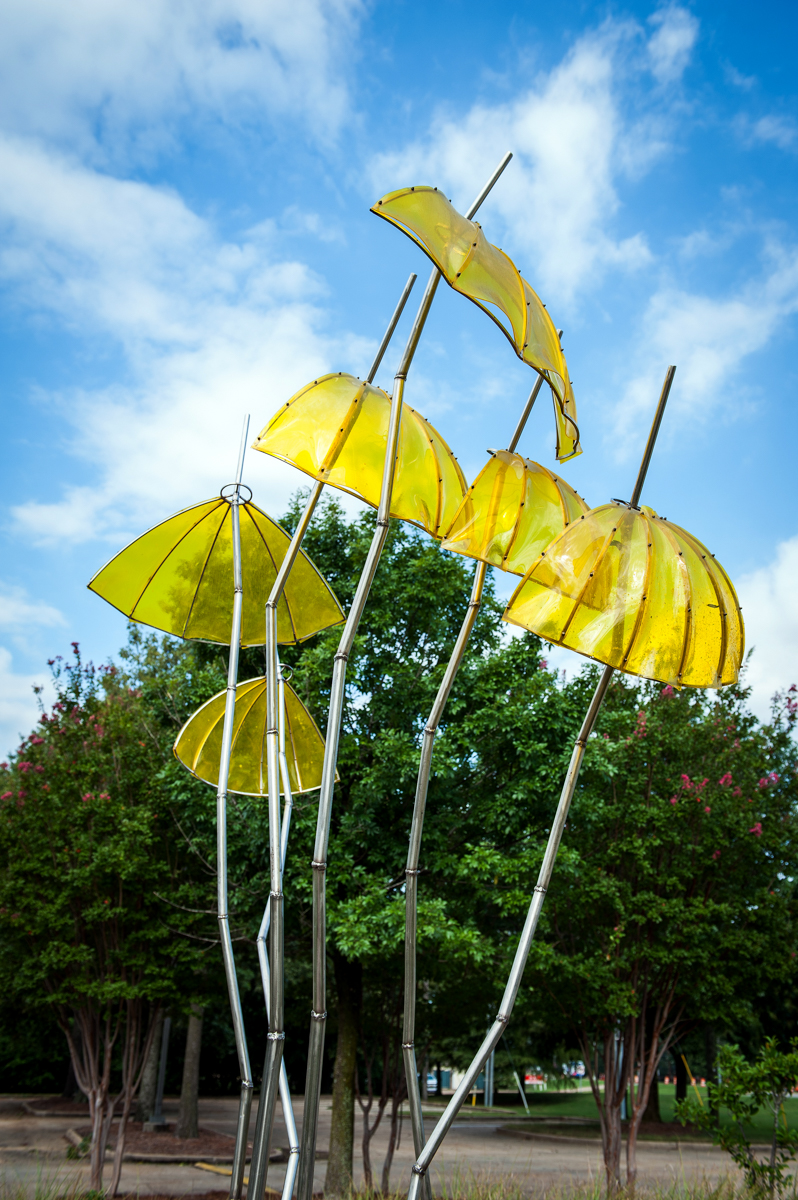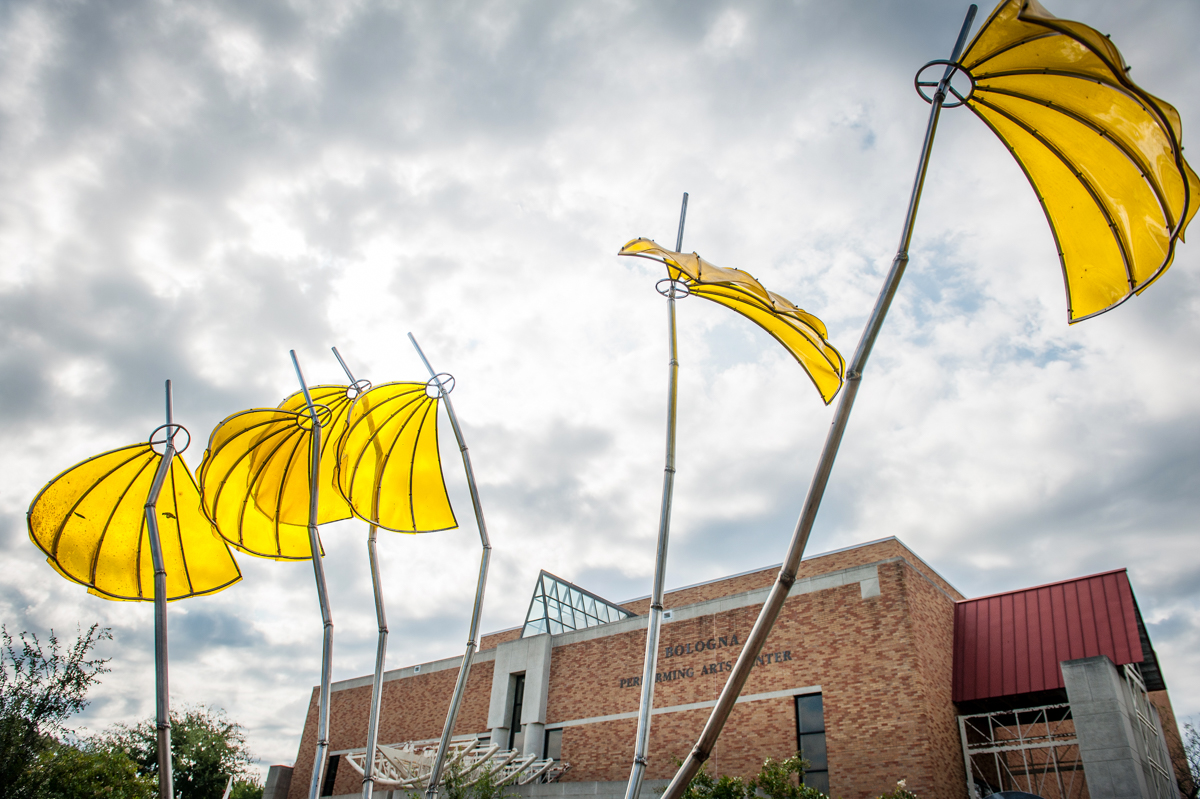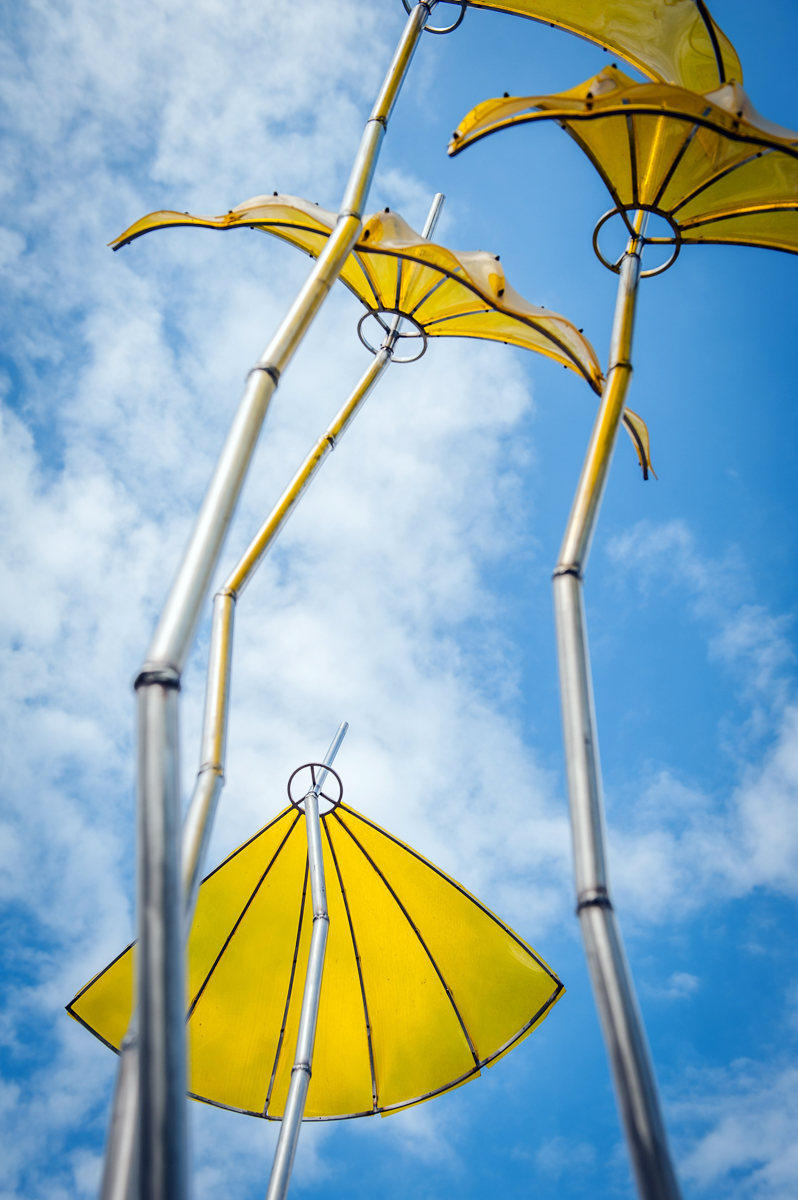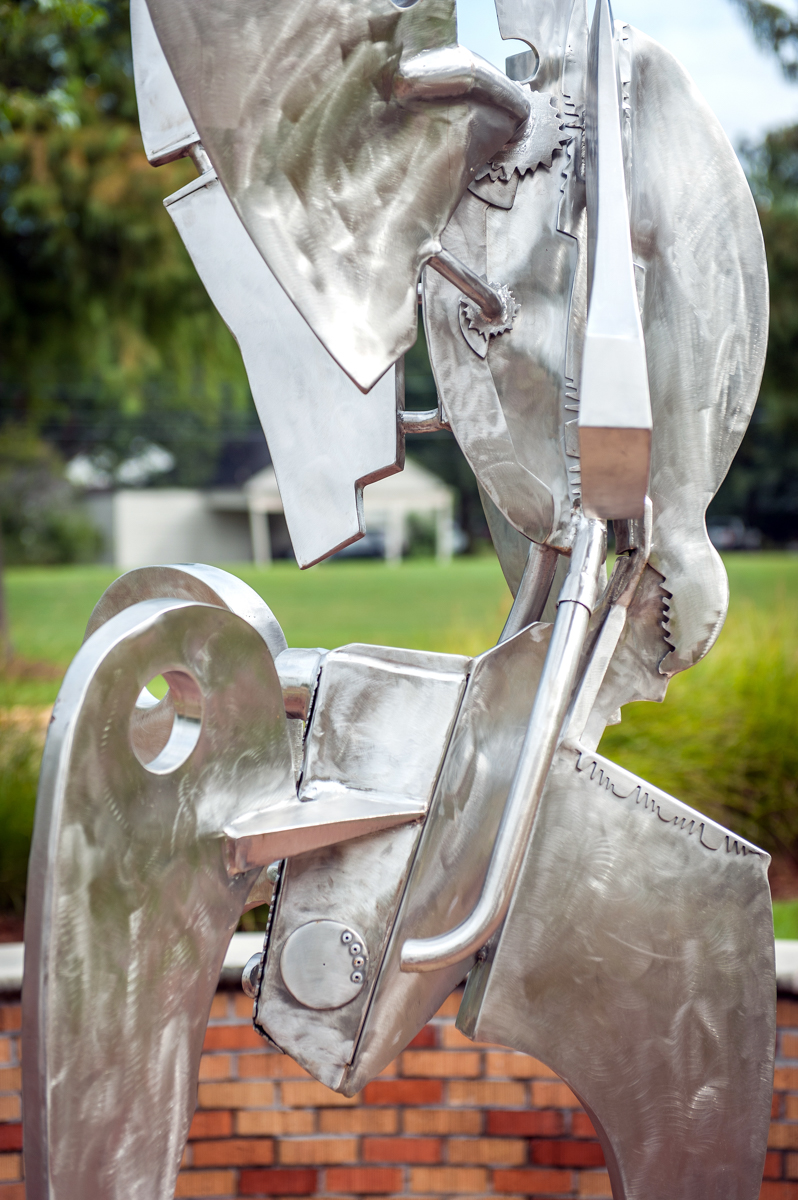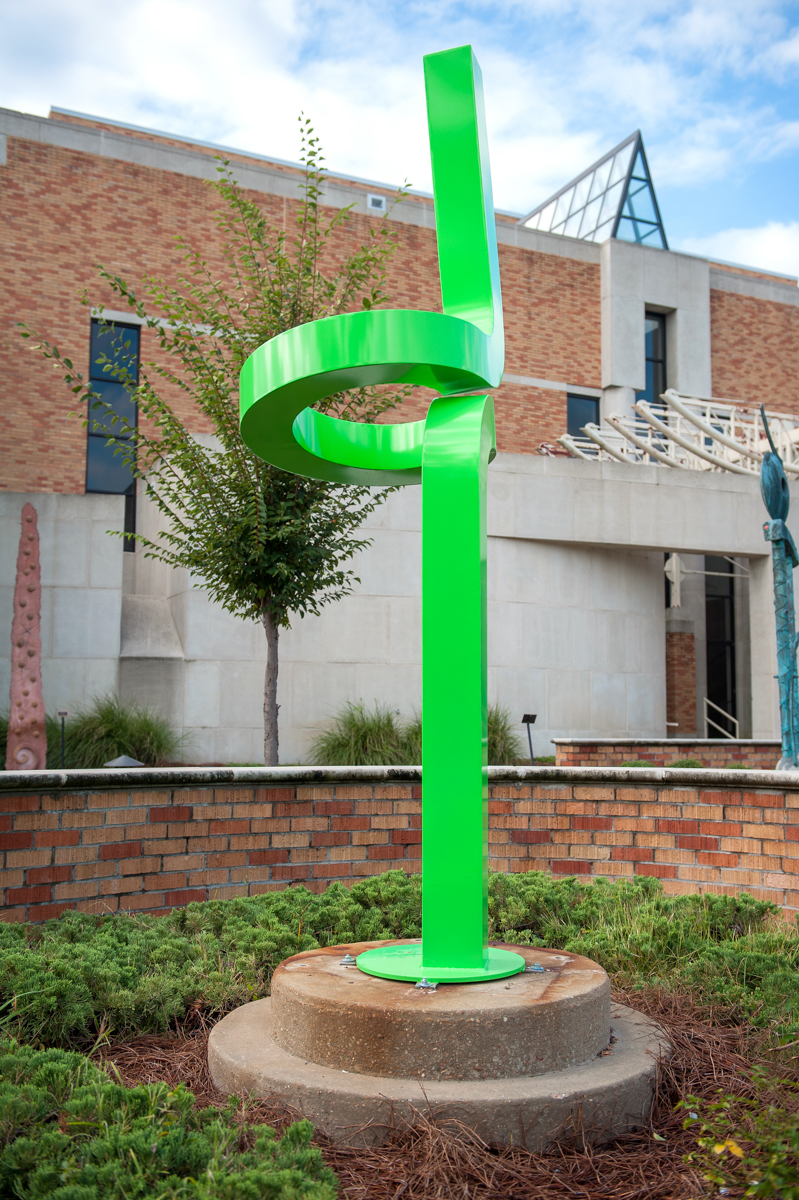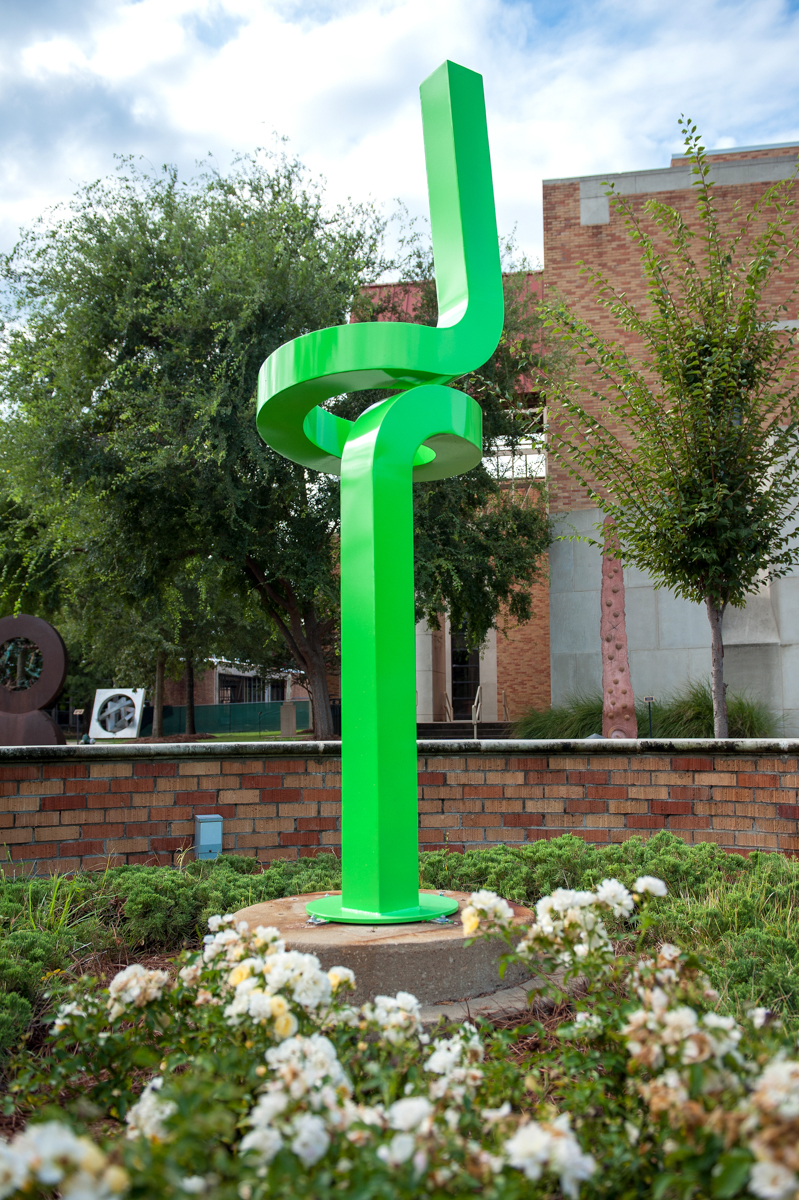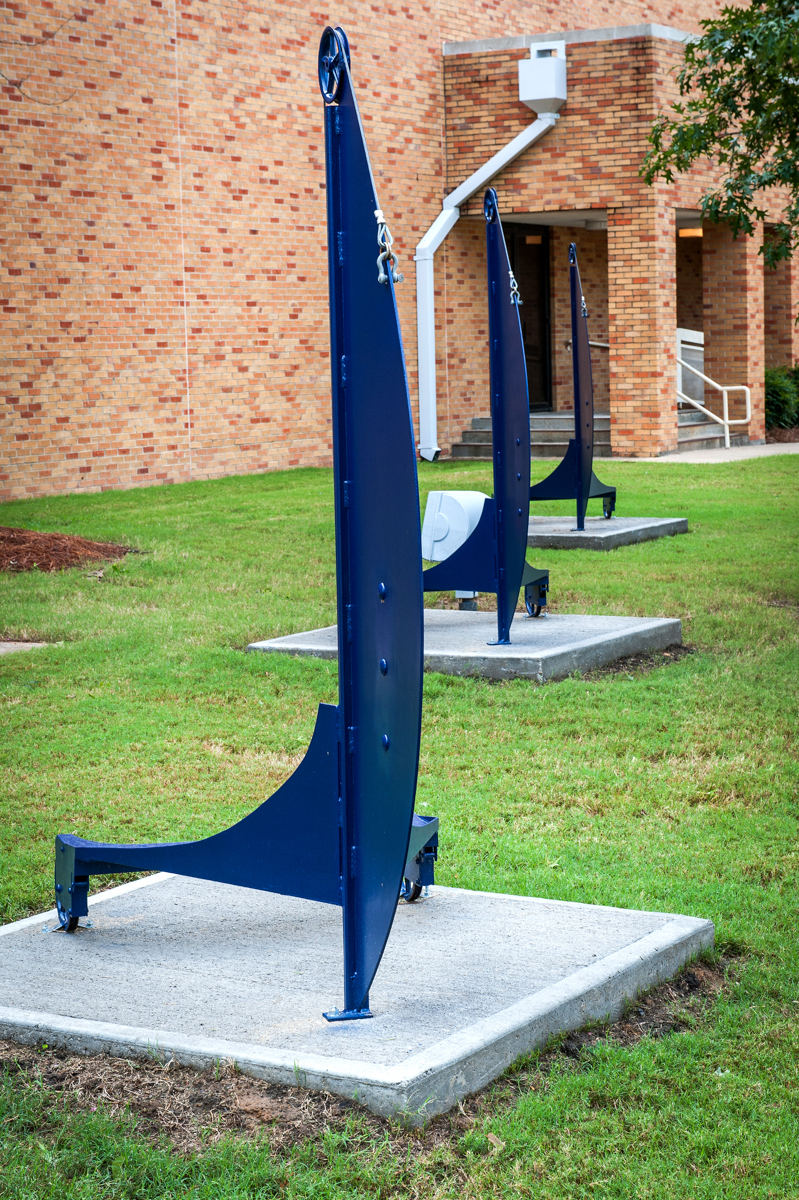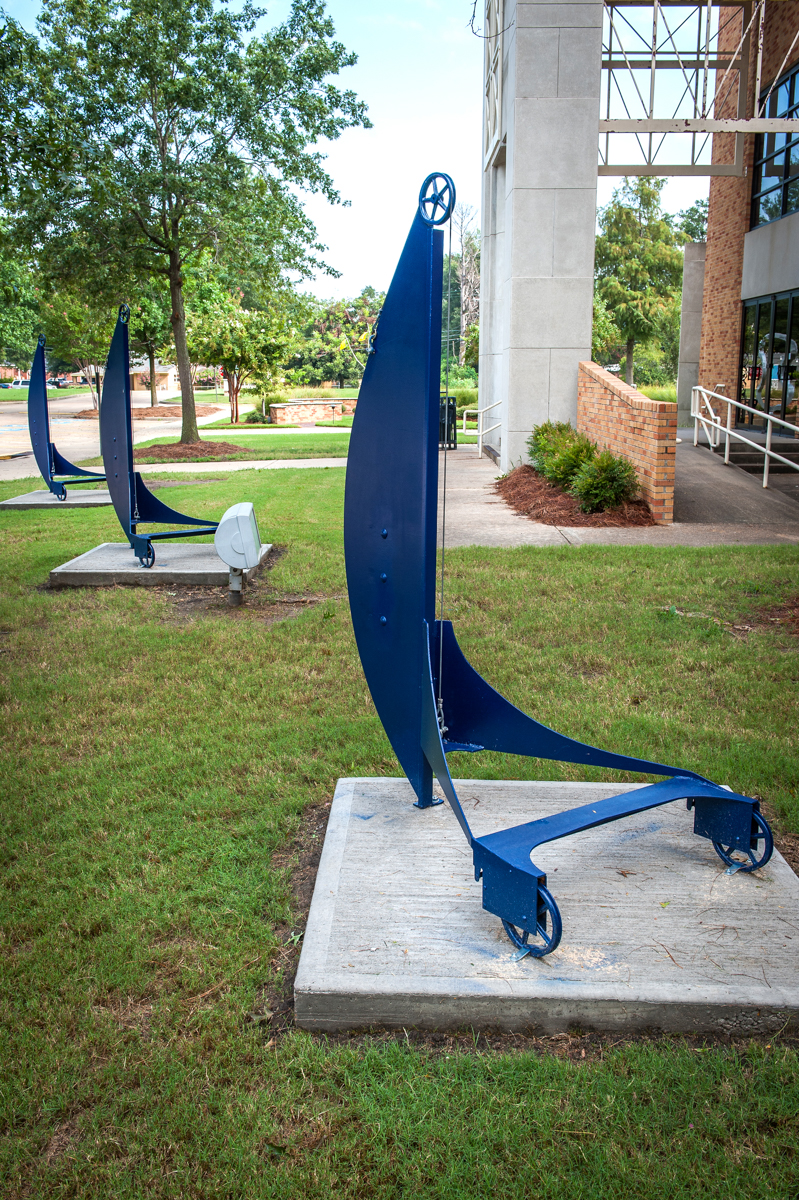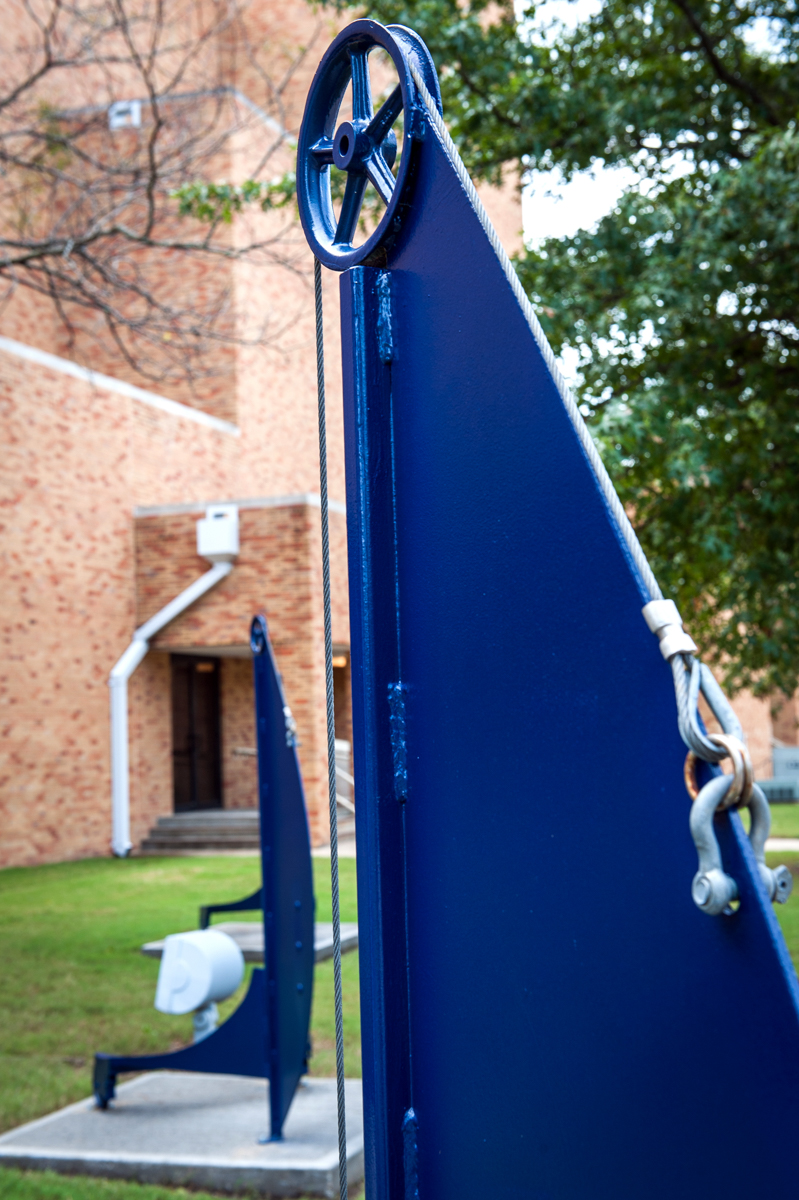Abstract. In a word, revered, veteran sculptor Ray Katz describes his compositions – most especially this year’s entry King of Spades – as “(My sculpture is) abstract – the abstract manipulation of form in space to create visual balance, using rhythm, action and movement.” The Michigan metal man continues, “My creative process requires organizing separate parts into a whole. I first fabricate all separate, solid, active pieces, and then let the process of creating happen organically and quite spontaneously, very instinctively and intuitively.” The puzzle-like assemblage “adds to the aura of complexity in the work. These activated forms are brought together to represent the flux of life and embrace transformative concepts such as evolution, metamorphosis and transcendence. This is what continually inspires me, continually allows me to ground to explore,” Katz concludes.
Greatest Sum by Taylor Barnett
An admitted “obsessive forager,” Taylor Barnett jokes, “I have the hardest time looking up. I am constantly looking at the ground, surveying for pieces – whatever those may be, bottlecaps that strike me interesting, rocks that catch my eye, small glass pieces that shine brightly. I find infinite beauty in those cast offs – whether by human hand or nature.” This capturing of “what others don’t see or choose not to see value in” started early in her childhood and set the eventual path for Barnett’s inaugural entry into the Mathews-Sanders Sculpture Garden, Greatest Sum. “This piece centers solely on that idea of cast offs and repurposing those, reinventing them, reimagining their story and meaning and paying close attention to what happens when these scraps, throw-aways, delinquent cast offs deemed unnecessary and impure in someone else’s art or story merge and unite in this piece to reveal great power and beauty and strength.” A Mississippi native, Barnett admits, “The time I spend organizing these pieces into a skeleton design, the time I’m on the ground moving and removing, adding and subtracting pieces to tell these stories or the story; man, that’s it, right there. That’s play time for me. That’s the ‘why’ to why I do this.”
Triumphal Arch by Robert Porreca
A Pittsburgh, Pennsylvania native, Porreca bucked family roots, trading the eastern coal mines for an art studio. “At the great behest of my family, I went into the arts and was an art teacher for 30-plus years,” he explains. “I didn’t always have the time to market my own art because when I got home from school, I was Dad to three girls. I’m retired now; I have the time and I’m doing it.” And “doing it,” big – literally, as Triumphal Arch stands 9 feet tall and is constructed of epoxy resin, fiberglass, carbon fiber and some hidden polyvinyl chloride pipe for support. Of the inspiration, Porreca explains,“Maquette after maquette, I just couldn’t let this idea go. I wanted to combine this idea of a Roman triumphal arch and the Greek Winged Victory of Samothrace, also called the Nike. What I’ve brought is my interpretation of these two powerful things that I’ve been fascinated with for some time and how they would look combined. I just had to make this piece.” But then again for this renewed and energetic septuagenarian, making is his lifeline. “I have to make because I breathe. I breathe because I’m making art.”
SCBS #9 by Matt Amante
“The proverbial student,” Matt Amante proudly declares. Despite his professor moniker at Pitt Community College in Winterville, North Carolina, Amante insists, he is no different than the very students he instructs. “Might I have more experience than them? Sure, yes; but I’m still a student. I don’t stop learning. I don’t think anyone should ever be completely through learning – not as artists, not as human beings. I would hope we share a yearning to constantly evolve,” he says. “That is the principle behind this piece, SCBS #9 – the second in the series I am bringing to Mississippi this year. It’s self-study challenge to only design with the circular forms and the river rocks.”
Spark by Phil Proctor
“Spark is an up-close look at that moment of energy released when a hammer strikes a piece of hot iron,” newcomer to the Garden, Phil Proctor explains. “It’s a point of view frozen in time.” Owner and proprietor of Nucleus Sculpture Studio in Georgia, the Mississippi native holds a Master of Fine Arts in Sculpture from East Carolina University and a Bachelor of Fine Arts in Sculpture from the University of Southern Mississippi and has been a professional sculptor practicing in Atlanta since 2003. “As a sculptor, I strive to design and execute artworks that intrigue and inspire a viewer about their place in an environment or space,” Proctor continues. “My work exhibits a relationship between our existence as a human species and the universe in which we exist, and I think that is particularly true with this piece. Spark is intended to encourage the viewer to observe a seemingly ordinary event from multiple perspectives – a technique which promotes open mindedness and critical thinking.”
Almagestum I by Jon Whitfill
“This piece is named after a book, which is arguably the most important scientific treatise written in the last two thousand years. All scholars across the globe in countless languages, and different regions studied this book to understand the nature of the spherical universe – which included the celestial sphere endlessly rotating around the motionless, spherical Earth,” newcomer Jon Whitfill brilliantly explains. “The fascinating thing about this wonderful tome is that almost all of it has been disproven in the past couple of hundred of years. The originator of this treatise, an astronomer named Claudis Ptolemy, knew that there was something wrong with his perfectly circular and spherical model of the universe, but no educated scholar could deal with the fact that heavens weren’t built with perfect circles and perfect spheres.” Counted among those resistant scholars is Whitfill, himself. A science “nerd” and physics teacher for over a decade, he continues, “I guess, I, myself, hold some of these prejudices against ellipses and other ovular forms that ancient scholars held. There is something about the circle, and a spinning circle forming a spherical shape that just makes my heart sing.” Almagestum stands 10 feet tall and is fabricated from powder-coated, welded steel. “This piece is everything about my earliest roots on display and I am proud to have it, here, on display among such a fine cadre of sculptures and artists.”
Intrusion by Harry McDaniel
One of seven rookie exhibitors to be featured in this year’s campus selections, Harry McDaniel brings Intrusion from his Asheville, North Carolina studio. Intrusion is constructed of steel, aluminum and powder-coat paint. “Intrusion was a piece that I made over the course of several years, and when I first began, I was working, primarily, in steel. I knew from my crude sketches and the maquette process, that I wanted the three pieces to be different colors; so when I finished fabricating the first piece and painted it red, it was still missing something,” McDaniel recalls. “So, I went to add texture by grinding and I really liked the way it was turning out, but I very quickly realized, this is going to take forever and it nearly did; so the truth is, by this point in the process, I was becoming more and more familiar with stainless steel and that’s why the third piece is not orange, as I had originally intended and instead, that stainless steel – which I think really adds depth to the piece.” This “happy timing,” as he refers to it now, gave Intrusion the depth necessary to accomplish McDaniel’s first goal with the piece. “I wanted to create an engaging sculpture that invited the audience to interact with it, to walk around it and experience it from all angles, all perspectives. I wanted the viewer to explore his/her relationship with space and the piece, just as this piece explores the relationship between three competing perspectives for space. You can really ask yourself from which side, which perspective is the intrusion coming?”
Amongst by Hanna Seggerman
The saying, “You never know when inspiration will find you,” could not be more true for Kingsley, Iowa native, Hanna Seggerman. While hiking along the Cedar Falls River, just minutes from her alma mater, the University of Northern Iowa, with her teeth chattering and her face burnt from the frost, she was undeterred, stubbornly determined to practice shooting with her new camera. “I think I was in Photo II class, and I knew I needed to be out there practicing. I knew I needed to be working with that camera. I’m looking at the river, the trees, the landscape all around me and then I see these rocks, placed so perfectly and they had ice so beautifully wrapped around them, almost like it was sewn. It was absolutely pristine, like beyond just pretty,” she describes. That photograph propelled sketches, which multiplied to more sketches and then finally a maquette, to what now houses property just left of the steps by the East Entrance of the Bologna Performing Arts Center. Just her second time to install this sculpture and her first time to install outside of Iowa, Seggerman adds, “My work is super personal to me, I think most artists would say that. Having a piece that so many complete strangers are going to come into contact with, that’s scary and completely exhilarating all in the same crazy breath. I would hope they see things that may appear so unconnected or share a juxtaposition, can grow with each other, can be close together, can work together. That’s a concept that is really interesting to me.”
Bluestone Blues by Glenn Zweygardt
Glenn Zweygardt continues his long-standing relationship inside the Mississippi Delta with his installation of Bluestone Blues. A venerable, New York-based sculptor, he has gained world-wide recognition over his nearly six-decade career and a membership to the Berman Group, a cooperative of sculptors whose collective work spans virtually the entire spectrum of possibilities of “traditional” modernist sculpture. Zweygardt has seven pieces featured in the Mathews-Sanders Sculpture Garden Permanent Collection, and on this journey south brings Bluestone Blues. “Finding one’s place in a relationship with nature is the theme of my sculpture,” he explained. “While working with materials such as metal and stone, a relationship between nature and myself is formed. Further, I want to tell stories and comment on my collective life experience and my perception of a collective consciousness. Hopefully, these ideas and expressions will enter into human consciousness and the fourth dimension.”
To Focus by Ben Pierce
Standing 8 feet tall and constructed of welded steel and macropoxy paint, To Focus marks Ben Pierce’s fourth acceptance into the Mathews-Sanders Sculpture Garden Competition, but the first from his 2015 “Balance” series. The Cape Girardeau, Missouri native is candidly vulnerable about his emotional struggles of the past, levying, “2015 was a challenging time for me. I lost who I was. I found myself in the bottom of a dark hole, maybe the only thing that kept me going was my artwork. I dove head first into designing and making new work.” However, he imposed “limitations on his creativity,” allowing himself only the elements of two straight lines and a circle. “Those were the guidelines and I wanted to see how many unique and interesting compositions could be born from that infrastructure. What’s interesting is that when you have that few elements, you really have to shift the perspective and play with the balance – moving things in and out, to and from, incorporating cantilevers – to create a composition that has appeal or aesthetic.” Through the actual fabrication and the act of doing, Pierce made a profound realization, “I thought I was escaping into my art and avoiding my problems. However, during the fabrication of these sculptures I confronted myself; all the hurt, all the insecurities. I continue to do so every day still and what I’m coming away with each time: Love is a seed it will grow if you water it.”
Magnolia Bluff by Aaron Hussey
Growing up in New Orleans with its rich and distinctive history and cultural atmosphere, and being raised by arts-centric, arts-valuing parents, Aaron Hussey was magnetically drawn to the arts and most specifically – public art, for as long as he can remember. “I have to be making. I have to be creating something. I have to make art, it’s the only thing I want to do,” he confesses. His recent creation, Magnolia Bluff, allows for Hussey’s return to the Mathews-Sanders Sculpture Garden and sees the Baton Rouge-based artist revisit a consistent theme throughout his entire artistic catalogue. “This was a key piece for me; it was a step-off to this whole series that marries this connection between the built environment with the natural environment,” he explains. “It’s meant to continue exploring the basic infiltration of this – the Earth, with our structural presences, as humans. What are our interactions destructing in nature?” Fabricated of corten steel, stainless steel and painted steel, this 2011 sculpture is constructed to have tree-like qualities and also possess windows near the bottom half of the physical structure. “Yeah, that’s another common idea in my pieces, for sure – this idea of a portal, or doorway. I think the hope there, is that someone will look at it with a different perspective. What does it mean to see something from the other side or what does it require to cross the threshold to other side? What can be gained from that? What awaits us there?”
The Wandering Wall of Strange Ideas by Mark Dickson
THE WANDERING WALL OF STRANGE IDEAS, MARK DICKSON
The Mathews-Sanders Sculpture Garden
A first-time exhibitor inside the Garden, Mark Dickson showed previously as part of the inaugural Competition Class at the GRAMMY® Museum Mississippi with Guitar Man, a piece that was purchased for the Mathews-Sanders Sculpture Garden Permanent Collection. Dickson returns this year with two offerings, the first being The Wandering Wall of Strange Ideas. A magnetic, charismatic piece, Dickson ranks this work as his favorite production to date. “It’s my storyteller and it seems everyone that sees it, experiences it, engages with it, is drawn to it – whether it be because they’re envisioning a window, a door, a gate; a portal of some sort. It’s transporting and for me, it’s therapeutic to be free to just create something, anything and these 15 little vignettes allowed me just that opportunity. It was so freeing to just go and create and see what happens with these wonderful materials.”
Stargazer by Ray Katz
STARGAZER, RAY KATZ
The Mathews-Sanders Sculpture Garden
A Detroit, Michigan native, Ray Katz is an internationally-known sculptor and a veteran of outdoor installations. Stargazer marks the third time Katz has shown in the Mathews-Sanders Sculpture Garden and his pieces always deliver bold, open geometric offerings. “[This piece] is a celestial experience, visually. It’s almost like something is floating in space, and that was my primary interest in developing the celestial quality, even spirituality, endowed in the piece. I have been fascinated with the celestial theme and its bearing on the growth in our lives, with respect to the things we address ourselves to.”
The Arrangement of Three Circles by Ben Pierce
THE ARRANGEMENT OF THREE CIRCLES, BEN PIERCE
The Mathews-Sanders Sculpture Garden
With the inclusion of The Arrangement of Three Circles into this year’s Competition Class, The Mathews-Sanders Sculpture Garden welcomes its first-ever kinetic sculpture to Delta State University’s campus. The sculpture is named quite accurately, as Missouri-based sculptor, Ben Pierce explains, “It is, literally, three circles cut up and rearranged, but in the process, reinvented as a shape that doesn’t read like a circle.” As for the kinetic aspect, Pierce continues, “I have always believed public art should be interactive, whether that means how you walk through, touch it, knock on it to see what it is made of…Kinetic art allows you to take that to the next level. You can push the piece, stand on the piece, ride the piece. It allows you to shift your perspective and see the piece from so many more angles. I love that challenge.”
Symbiosis by Rick Herzog
SYMBIOSIS, RICK HERZOG
The Mathews-Sanders Sculpture Garden
Born to a family of scientists, specifically the hard sciences of physics, chemistry and mathematics, Rick Herzog showed no interest in his familial pursuits. “As an artist I do not have the answers, I feel my role is more like an activist. My role is to bring awareness to the society in which we live and to the subjects, objects and ideas that permeate our culture in a subordinate or subversive manner,” Herzog explains. “My current work explores botanical forms, the lack of interaction between man and nature, our disconnection from this environment and the ‘artificialization’ of nature, natural spaces and all things living. These sculptures talk about organization and the chaotic nature within natural and man-made forms. I look at how items are composed and their many parts, then abstract their elements – keeping true to their inherit qualities. Some sculptures are more organic in form as if growing or flowing from group to group, mimicking ivy or spring flowers sprouting here and there.”
Sky Sentinel
SKY SENTINEL, MARK DICKSON
The Mathews-Sanders Sculpture Garden
Standing nearly 10ft. tall, Sky Sentinel is a first for Tallahassee-based sculptor, Mark Dickson. “Sky Sentinel is a stainless steel piece, and this is really the first time I’ve worked this big in this material. Stainless steel is such a wonderful and interesting material to work in,” he explains. “It has such an innate beauty, if it is done right.” A figurative piece, Dickson attempted to marry the human form to the machine in Sky Sentinel. “I wanted to interpret this idea of bioengineering – a machine with a soul, with almost this angelic form,” he continues. “There is something really powerful to that form.”
Sprout by Ben Pierce
SPROUT, BEN PIERCE
The Mathews-Sanders Sculpture Garden
Returning for his second installation inside the Garden, Ben Pierce is presenting Sprout, an abstracted form of a seedling or plant, as the first piece in an eventual series focused on growth. Having experienced his own personal growth by transitioning to full-time artist since his last visit to the MS Delta two years ago, Pierce is invigorated by his new freedom and seeks to challenge himself with the creation of each new sculpture. “I want to learn something new with each piece and I want to constantly evolve as an artist. I think by minimizing the outside distractions and minimizing the materials I’m using, I’m left focused on the design. I think there is a great challenge in keeping things simple. When there are less things to distract you and less things to look at, what you are left with is the pure design element of it and the craftsmanship,” he explains. Sprout also marks the first and only time Pierce has powder-coated a piece. “Over the neon green color, I added a clear sparkle coat and it adds an element of glow during the dusk and dawn.”
Adrift II by Durant Thompson
ADRIFT II, DURANT THOMPSON
The Mathews-Sanders Sculpture Garden
An Associate Professor at the University of Mississippi, Durant Thompson returns to the campus collection, having originally debuted his work in Competition Class IV. His latest submission, Adrift II, marks the first time the three boat-like pieces are being shown collectively and he is thrilled with its presentation. Additionally, it stands as the inaugural presentation of Thompson’s work with color, having painted this trio a monochromatic blue. “Originally, this piece wasn’t a conceptualized piece. The entire thing was created from what we call drop, or the metal left behind from cutting other pieces. Those curves were just lying there, and I saw this flash of inspiration and went from there; the pieces told me what they wanted to be,” Thompson explains. “Visually, I wanted the piece to reflect calm, the calmness you can feel when out there on the water.”




















